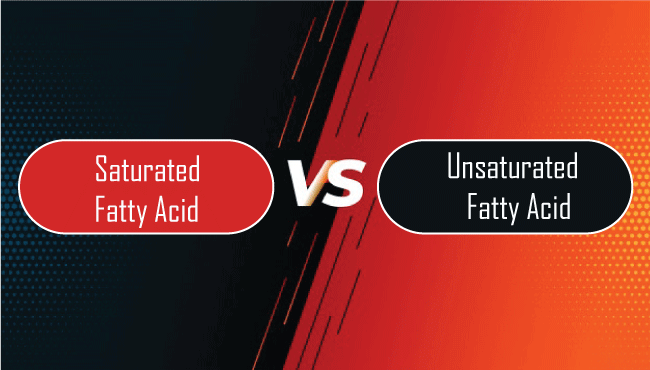Difference between saturated and unsaturated fatty acids
Humans, animals, and plants need the energy to sustain the proper functioning of the body that is attained from the consumed food consisting of carbohydrates, minerals, vitamins, proteins, and fats. Fat is one of the important nutrients the body requires to keep us healthy and protect our tissues. Fatty acidA fatty acid is a biological term in humans, plants, and microorganisms. These are hydrocarbon chains terminating with carboxylic acid groups. Fatty acids are lipids or fat-soluble components of living cells that consist of an even number of carbon atoms with a hydrogen atom and a carboxyl group (-COOH) at the other end. These are the subunit of oils, fats, and waxes produced by the hydrolysis breakdown of fats such as phospholipids and triglycerides. Other lipids are sphingolipid, glycerol, sterol lipid, and prenol lipid. The fatty formula is CnH2n+1COOH (synthesized by two carbons each time to malonyl-CoA). There are two types of fatty acids: Saturated fatty acid and unsaturated fatty acid (depending on the nature of the covalent bond). Most living organism body needs both kinds of fats (saturated and unsaturated) for their regular activities. A higher portion of fat comes from unsaturated fats, and the overconsumption of saturated fat increases the body's bad cholesterol. This situation exerts the risk of cardiovascular disease or cardiac disease by clogging the arteries but unsaturated fat help in keeping the proper functioning of the body. Saturated fatty acidWhen in fats, the carbon atoms are saturated with hydrogen atoms and don't have a double bond between carbon atoms is termed as a saturated fatty acid. These are found in these kinds of food:
In most cases, saturated fats are not good for health as they are responsible for life-taking diseases like:-
Unsaturated fatty acidThese kinds are chemical, with one or more double or triple bonds between carbon atoms. This consistency makes these fats liquid at room temperature, i.e., in oil form at room temperature. These kinds of food have unsaturated fats:
Unsaturated fat has various benefits: Protecting the body's organs, supporting cell growth, fueling the body, producing important hormones, and promoting nutrient absorption. Unsaturated fats types: Monounsaturated fats and Polyunsaturated fats. Monounsaturated fats: Products like peanut, olive, and canola oil are counted in monounsaturated fat, having one double bond per molecule. They are the healthiest fat as they have low cholesterol, bad cholesterol, and triglycerides (the amount of circulating fat in the body). Polyunsaturated fats: The body can't make them; they can be consumed via some food. They are divided into two groups such as omega 3 (alpha-linolenic acid) and omega 6 (linoleic acid). These fats help in building blocks in the membrane surrounding your body's cells and contribute to the brain's structure. Seafood is mainly rich in omega three fat (known as EPA and DHA) that help control inflammatory reactions. Trans fat: Called trans fatty acid, made by hydrogenation process (heating vegetable oil in the presence of a catalyst and hydrogen gas). The best examples of trans fat are hydrogenated edible vegetable oils used for cooking. They can be repeatedly heated without breaking down, making them ideal for frying fast foods, baked goods, processed snacks, and margarine. They are more stable and less likely to become rancid, responsible for heart disease, chronic conditions, stroke, and diabetes. Guideline for consumption of fatsBefore consuming food, we must attain limited calorie amounts because food has different fats. So here are some of the dietary guidelines for everyday consumption:-
Difference
Conclusion:It is difficult to conclude which fat should be consumed or avoided as both have pros and cons, but both are beneficial in limits. So to choose the best option according to your body, the user must consult the doctor and include foods in their diet that are rich in nutrients and lower in calories. Food must be unprocessed and natural to keep the body healthy.
Next TopicDifference between
|
 For Videos Join Our Youtube Channel: Join Now
For Videos Join Our Youtube Channel: Join Now
Feedback
- Send your Feedback to [email protected]
Help Others, Please Share










